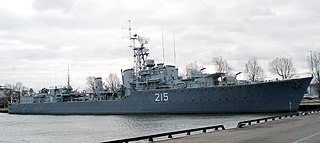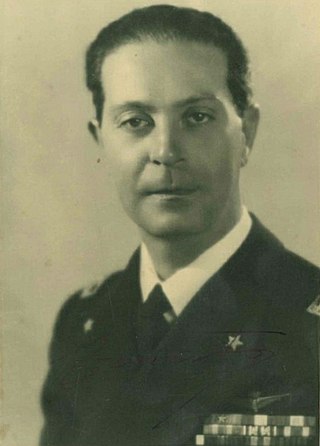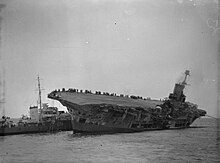
HMS Ark Royal was an aircraft carrier of the Royal Navy that was operated during the Second World War.

Force H was a British naval formation during the Second World War. It was formed in late-June 1940, to replace French naval power in the western Mediterranean removed by the French armistice with Nazi Germany. The force occupied an odd place within the naval chain of command. Normal British practice was to have naval stations and fleets around the world, whose commanders reported to the First Sea Lord via a flag officer. Force H was based at Gibraltar but there was already a flag officer at the base, Flag Officer Commanding, North Atlantic. The commanding officer of Force H did not report to this Flag Officer but directly to the First Sea Lord, Admiral of the Fleet Sir Dudley Pound.

Operation Rheinübung was the last sortie into the Atlantic by the new German battleship Bismarck and heavy cruiser Prinz Eugen on 18–27 May 1941, during World War II. This operation aimed to block Allied shipping to the United Kingdom as the previously successful Operation Berlin had done. After Bismarck had sunk HMS Hood during the Battle of the Denmark Strait, it culminated with the sinking of the Bismarck, while Prinz Eugen escaped to port in occupied France. From that point on, Germans would rely only on U-boats to wage the Battle of the Atlantic.

HMS Cossack was a Tribal-class destroyer named after the Cossack people of the Eurasian steppe. She became famous for the boarding of the German supply ship Altmark in Norwegian waters, and the associated rescue of sailors originally captured by the Admiral Graf Spee. She was torpedoed by the German submarine U-563 on 23 October 1941, and sank four days later.

The Tribal class, or Afridi class, was a class of destroyers built for the Royal Navy, Royal Canadian Navy and Royal Australian Navy that saw service in World War II. Originally conceived during design studies for a light fleet cruiser, the Tribals evolved into fast, powerful destroyers, with greater emphasis on guns over torpedoes than previous destroyers, in response to new designs by Japan, Italy, and Germany. The Tribals were well admired by their crews and the public when they were in service due to their power, often becoming symbols of prestige while in service.

Sink the Bismarck! is a 1960 black-and-white CinemaScope British war film based on the 1959 book The Last Nine Days of the Bismarck by C. S. Forester. It stars Kenneth More and Dana Wynter and was directed by Lewis Gilbert. To date, it is the only film made that deals directly with the operations, chase and sinking of the battleship Bismarck by the Royal Navy during the Second World War. Although war films were common in the 1960s, Sink the Bismarck! was seen as something of an anomaly, with much of its time devoted to the "unsung back-room planners as much as on the combatants themselves". Its historical accuracy, in particular, met with much praise despite a number of inconsistencies.

The Decima Flottiglia MAS was an Italian flotilla, with marines and commando frogman unit, of the Regia Marina. The acronym MAS also refers to various light torpedo boats used by the Regia Marina during World War I and World War II.

HMS Penelope was an Arethusa-class light cruiser of the Royal Navy. She was built by Harland & Wolff ; her keel was laid down on 30 May 1934. She was launched on 15 October 1935, and commissioned 13 November 1936. She was torpedoed and sunk by the German U-boat U-410 near Naples with great loss of life on 18 February 1944. On wartime service with Force K, she was holed so many times by bomb fragments that she acquired the nickname "HMS Pepperpot".

HMS Electra was a one of nine E-class destroyers built for the Royal Navy during the 1930s. Sunk in the Battle of the Java Sea, Electra was a witness to many naval battles, including the Battle of the Denmark Strait and the sinking of Prince of Wales and Repulse. The ship's wreck was discovered in 2003 and had been badly damaged by illegal salvagers by 2016.

HMS Legion was an L-class destroyer of the Royal Navy. She entered service during the Second World War, and had a short but eventful career, serving in Home waters and the Mediterranean. She was sunk in an air attack on Malta in 1942. The ship had been adopted by the British civil community of the Municipal Borough of Cheltenham, Gloucestershire in November 1941.

The last battle of the German battleship Bismarck took place in the Atlantic Ocean approximately 300 nautical miles west of Brest, France, on 26–27 May 1941 between the German battleship Bismarck and naval and air elements of the British Royal Navy. Although it was a decisive action between capital ships, it has no generally accepted name. It was the culmination of Operation Rheinübung where the attempt of two German ships to disrupt the Atlantic Convoys to the United Kingdom failed with the scuttling of the Bismarck.

HMS Firedrake was an F-class destroyer built for the Royal Navy during the early 1930s. Although assigned to the Home Fleet upon completion, the ship was attached to the Mediterranean Fleet in 1935–36 during the Abyssinia Crisis. During the Spanish Civil War of 1936–39, she spent much time in Spanish waters, enforcing the arms blockade imposed by Britain and France on both sides of the conflict.

HMS Forester was one of nine F-class destroyers built for the Royal Navy during the early 1930s. Although assigned to the Home Fleet upon completion, the ship was attached to the Mediterranean Fleet in 1935–36 during the Abyssinia Crisis. A few weeks after the start of World War II in September 1939, she helped to sink one German submarine and then participated in the Second Battle of Narvik during the Norwegian Campaign of 1940. Forester was sent to Gibraltar in mid-1940 and formed part of Force H where she participated in the attack on the Vichy French ships at Mers-el-Kébir and the Battle of Dakar between escorting the aircraft carriers of Force H as they flew off aircraft for Malta and covering convoys resupplying and reinforcing the island until late 1941. During this time the ship helped to sink another German submarine.

HMS Fury was an F-class destroyer built for the Royal Navy in the 1930s. Although assigned to the Home Fleet upon completion, the ship was attached to the Mediterranean Fleet in 1935–36 during the Abyssinia Crisis. During the Spanish Civil War of 1936–1939, she spent time in Spanish waters, enforcing the arms blockade imposed by Britain and France on both sides of the conflict. The ship escorted the larger ships of the fleet during the early stages of World War II and played a minor role in the Norwegian Campaign of 1940. Fury was sent to Gibraltar in mid-1940 and formed part of Force H where she participated in the attack on Mers-el-Kébir and the Battle of Dakar. The ship escorted numerous convoys to Malta in 1940–41 and Arctic convoys during 1942.

The ship's cat has been a common feature on many trading, exploration, and naval ships dating to ancient times. Cats have been brought on ships for many reasons, most importantly to control rodents. Vermin aboard a ship can cause damage to ropes, woodwork, and more recently, electrical wiring. In addition, rodents threaten ships' stores, devour crews' foodstuff, and can cause economic damage to ships' cargo, such as grain. Vermin are also a source of disease, which is dangerous for ships that are at sea for long periods of time. Rat fleas are carriers of plague, and rats on ships were believed to be a primary vector of the Black Death.

HMS Laforey was an L-class destroyer of the Royal Navy. She was commissioned in and served during the Second World War, and was torpedoed and sunk by a U-boat in 1944. She had been adopted by the civil community of Northampton in November 1941.
Thames was a rescue tugboat that saw service with the Royal Navy during the Second World War.

HMS Lively was an L-class destroyer of the Royal Navy. She served during the Second World War, and was sunk in the Mediterranean in an air attack on 11 May 1942.

HMS Lightning was an L-class destroyer of the Royal Navy. She was launched on 22 April 1940 and sunk on 12 March 1943 by German Motor Torpedo Boat S-55.

The second HMS Wivern, was a Modified W-class destroyer of the British Royal Navy that saw service in World War II.






















